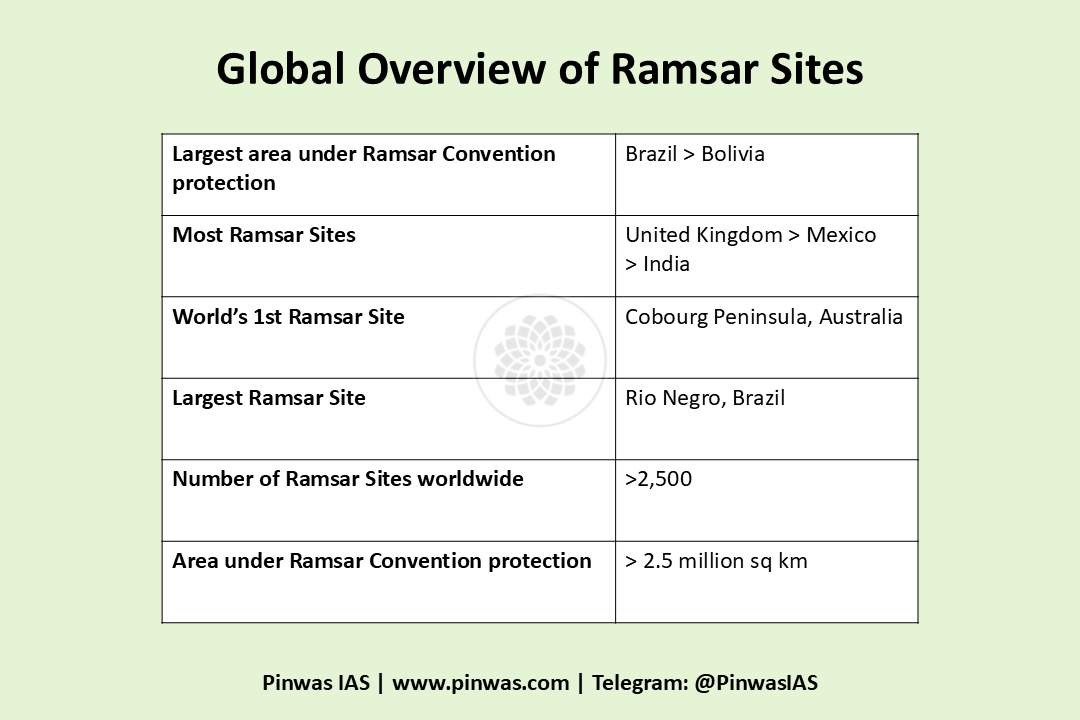Environment · 3 minutes read

The Ramsar Convention is an international treaty for the conservation and sustainable use of wetlands of international importance. It was named after Ramsar, Iran, where it was signed in 1971. India signed the Ramsar Convention in 1982. It now has one of the fastest-growing networks of Ramsar Sites. As of 26 September 2025, India has 93 Ramsar Sites.
What is Ramsar Convention?
The Ramsar Convention was adopted on 2 February 1971 at Ramsar, Iran, and came into force in 1975. To mark the day of adoption of this convention, World Wetlands Day is celebrated annually on 2 February. Some key facts about this convention are as follows:
- Official Name: The Convention on Wetlands of International Importance especially as Waterfowl Habitat
- Mission: The conservation and wise use of all wetlands through local and national actions and international cooperation, as a contribution towards achieving sustainable development throughout the world.
- Members: 173 Contracting Parties
- Depositary: UNESCO → but the Ramsar Convention is NOT part of the United Nations, and it is responsible only to its Conference of the Contracting Parties (COP).
- Ramsar Secretariat: hosted by IUCN in Gland, Switzerland.
- Ramsar List/Sites: List of Wetlands of International Importance.
Global Overview of Ramsar Sites
The Ramsar List is the world’s largest network of protected areas, comprising over 2,500 Ramsar Sites that cover more than 2.5 million square kilometres. Some key facts about the Ramsar Sites in the world are as follows:
- Largest area under Ramsar Convention protection: Brazil > Bolivia
- Most Ramsar Sites: United Kingdom > Mexico > India
- World’s 1st Ramsar Site: Cobourg Peninsula, Australia → designated in 1974.
- Largest Ramsar Sites: Rio Negro, Brazil > Ngiri-Tumba-Maindombe, DR Congo > Queen Maud Gulf, Canada.
- There are 67 major transboundary Ramsar Wetlands.
What are Wetlands?
Wetlands are areas where water is the primary factor controlling the environment and the associated plant and animal life. They occur where the water table is at or near the surface of the land, or where the land is covered by water.
Six major wetland types are generally recognised:
- Marine: coastal wetlands, including coastal lagoons, rocky shores, seagrass beds and coral reefs.
- Estuarine: deltas, tidal marshes, mudflats, and mangrove swamps.
- Lacustrine: wetlands associated with lakes.
- Riverine: wetlands along rivers and streams.
- Palustrine: marshes, swamps and bogs.
- Human-made wetlands: fish and shrimp ponds, farm ponds, irrigated agricultural land including rice paddies, salt pans, dams, reservoirs, gravel pits, wastewater treatment ponds and canals.
According to the Ramsar Convention, wetlands are areas of marsh, fen, peatland or water, whether natural or artificial, permanent or temporary, with water that is static or flowing, fresh, brackish or salt, including areas of marine water the depth of which at low tide does not exceed six metres.
The Ramsar Convention has adopted a Ramsar Classification of Wetland Type, which includes 42 types, grouped into three categories:
- Marine and Coastal Wetlands
- Inland Wetlands
- Human-made Wetlands.
Montreux Record
Established in 1990, the Montreux Record is a register of Ramsar sites where changes in ecological character have occurred, are occurring, or are likely to occur as a result of technological developments, pollution or other human interference. It is maintained as part of the Ramsar List under the Ramsar Convention on Wetlands. Currently, the Montreux Record list includes:
- 46 Ramsar Sites worldwide.
- Two Indian Ramsar Sites: Keoladeo National Park and Loktak Lake.
